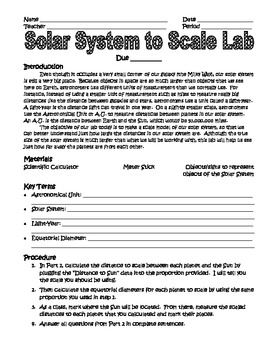Solar System to Scale Lab
Marissa St Louis
47 Followers
Grade Levels
8th - 9th
Subjects
Resource Type
Standards
CCSS8.NS.A.1
CCSS8.EE.A.3
CCSS8.EE.A.4
CCSSHSN-Q.A.1
CCSSHSN-Q.A.3
Formats Included
- PDF
Pages
3 pages
Marissa St Louis
47 Followers
Description
The objective of this lab is to make a scale model of our solar system, so as to better understand just how large the distances in our solar system are.
Materials Required
- Scientific Calculator
- Meter Stick(s)
- Objects/signs to represent each object in the Solar System
This lab is used in 8th grade physical science and 9th grade earth science. After students calculate the scale distances between each object in the Solar System, you then have the class make the scale solar system by placing labeled objects/signs and measuring each object's distances out to the scale they've calculated.
You can modify the lab to fit any scale you'd like. I have my students create the scale model down our hallway, which is about 50 feet long. You can do this in a space as small as the classroom, or as large as the football/track field. The numerator in the left side of the proportion on page 2 is left blank for you to create a scale that fits your needs. Once you've calculated the scale, you can either plug it in before you photocopy, or just have the students fill it in before they begin.
This lab meets the New York State NYS science standards, as well as the common core standards.
Materials Required
- Scientific Calculator
- Meter Stick(s)
- Objects/signs to represent each object in the Solar System
This lab is used in 8th grade physical science and 9th grade earth science. After students calculate the scale distances between each object in the Solar System, you then have the class make the scale solar system by placing labeled objects/signs and measuring each object's distances out to the scale they've calculated.
You can modify the lab to fit any scale you'd like. I have my students create the scale model down our hallway, which is about 50 feet long. You can do this in a space as small as the classroom, or as large as the football/track field. The numerator in the left side of the proportion on page 2 is left blank for you to create a scale that fits your needs. Once you've calculated the scale, you can either plug it in before you photocopy, or just have the students fill it in before they begin.
This lab meets the New York State NYS science standards, as well as the common core standards.
Total Pages
3 pages
Answer Key
N/A
Teaching Duration
40 minutes
Last updated Oct 13th, 2013
Report this resource to TPT
Reported resources will be reviewed by our team. Report this resource to let us know if this resource violates TPT’s content guidelines.
Standards
to see state-specific standards (only available in the US).
CCSS8.NS.A.1
Know that numbers that are not rational are called irrational. Understand informally that every number has a decimal expansion; for rational numbers show that the decimal expansion repeats eventually, and convert a decimal expansion which repeats eventually into a rational number.
CCSS8.EE.A.3
Use numbers expressed in the form of a single digit times an integer power of 10 to estimate very large or very small quantities, and to express how many times as much one is than the other. For example, estimate the population of the United States as 3 × 10⁸ and the population of the world as 7 × 10⁹, and determine that the world population is more than 20 times larger.
CCSS8.EE.A.4
Perform operations with numbers expressed in scientific notation, including problems where both decimal and scientific notation are used. Use scientific notation and choose units of appropriate size for measurements of very large or very small quantities (e.g., use millimeters per year for seafloor spreading). Interpret scientific notation that has been generated by technology.
CCSSHSN-Q.A.1
Use units as a way to understand problems and to guide the solution of multi-step problems; choose and interpret units consistently in formulas; choose and interpret the scale and the origin in graphs and data displays.
CCSSHSN-Q.A.3
Choose a level of accuracy appropriate to limitations on measurement when reporting quantities.




